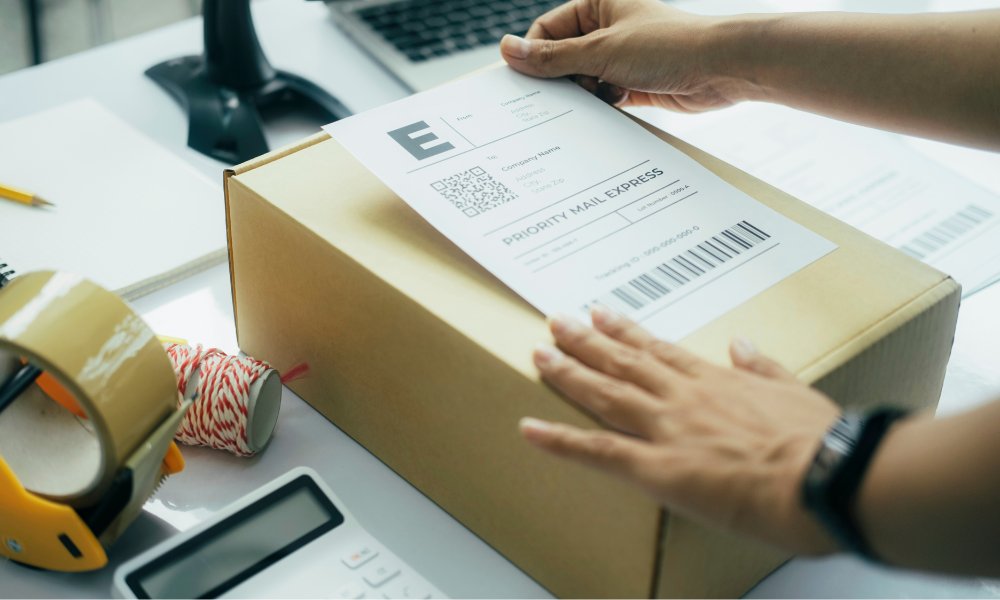In the fast-paced world of shipping and logistics, efficiency, clarity, and reliability are everything. From managing a busy warehouse, dispatching parcels from a fulfilment centre, or simply running an e-commerce operation, one thing remains consistent: your labelling system needs to work flawlessly, and it can with the help of thermal labels.
Thermal printing offers a robust, cost-effective, and high-performance solution that surpasses traditional alternatives in almost every way, from shipping labels to logistics labels, and from barcode labels to product tracking. In this article, we explore why thermal labels, particularly thermal transfer labels, are the best choice for shipping and logistics professionals who won’t compromise on quality.
What Are Thermal Labels?
Thermal labels are printed using heat rather than ink, making them ideal for high-speed, high-volume environments such as logistics and distribution. This ink-free process eliminates the need for messy cartridges, toners, or ribbons (in the case of direct thermal), reducing both operational costs and downtime. Because thermal printing relies on heat-sensitive materials, it produces clean, precise images and barcodes with exceptional durability.
This method also ensures consistent quality over large print runs, allowing warehouses and shipping centres to handle heavy workloads without sacrificing label readability or reliability. The simplicity and speed of thermal printing technology mean it can easily integrate into automated systems, supporting the fast-paced demands of modern logistics.
There are two main types:
Direct thermal labels – These use heat-sensitive paper and require no ink or ribbon. Perfect for short-term use where the label only needs to last a few days.
Thermal transfer labels – These use a heated ribbon to transfer ink onto the label, creating long-lasting, durable prints ideal for tougher conditions.
At Labels Zoo, we stock both options because we know no two operations are the same.

Why Thermal Labels Are Ideal for Shipping and Logistics
1. Speed and Efficiency
In logistics, time really is money. Whether you’re labelling 100 or 10,000 parcels a day, thermal printers keep up with demand. Thermal label printing is significantly faster than traditional inkjet or laser methods, meaning you can produce shipping labels and barcode labels on the fly without delays. This speed allows for real-time printing at packing stations or shipping points, enabling greater flexibility during peak times and reducing bottlenecks. Faster print speeds also mean less downtime for your team, smoother workflow, and increased overall productivity. Plus, because thermal printers require minimal maintenance and no ink changes, there’s less interruption to your operations, so you can keep your logistics moving efficiently and meet tight delivery deadlines with ease.
2. Unrivalled Print Clarity for Scanning
In a world driven by automation, your labels need to be scannable. Thermal printing produces crisp, high-contrast text and barcodes.
Whether your packages are being scanned by handheld devices, conveyor belt systems, or at point-of-delivery, the reliability of thermal-printed barcode labels ensures smooth operations without costly delays or manual interventions. Clear and precise printing reduces the risk of misreads and scanning errors, which can lead to shipment misrouting, lost parcels, or delayed deliveries.
This consistency not only improves the accuracy of your logistics chain but also enhances customer satisfaction by ensuring parcels arrive on time and are correctly tracked. Thermal labels deliver the performance your automation systems demand, helping you maintain a seamless flow from warehouse to doorstep.
3. Durability Where It Counts
Shipping and logistics labels don’t just need to look good when they leave your warehouse; they need to survive the entire journey. That includes handling, transport, temperature changes, and exposure to moisture or friction.
Thermal transfer labels are especially resistant to scratches and smudging, UV light, moisture and humidity, and abrasion during handling or shipping. That’s why they’re the gold standard for international shipping, pallet labelling, cold chain logistics, and more. Labels stay legible for the long haul, helping reduce lost parcels, scanning errors, and delivery disputes.
4. Cost-Effective at Scale
When you’re printing thousands of logistics labels every week, your costs can mount up fast. Thermal label printers have fewer moving parts than traditional printers, which means they’re less prone to breakdown and need less maintenance.
Direct thermal labels (for short-term applications) don’t require ribbons, ink, or toner, so they’re particularly economical for large volumes. And even though thermal transfer printing requires ribbons, the added durability often saves money in the long run by reducing relabelling, errors, and returns.
5. Flexible for Multiple Applications
Thermal labels aren’t just for parcel dispatch; they can be used across your entire logistics operation:
- Shipping labels for courier services like Royal Mail, DPD, or Evri
- Barcode labels for warehouse inventory management
- Product ID labels for picking and packing
- Pallet labels for freight shipping
- Returns labels for customer service
With a wide range of sizes, adhesives, and materials available, you can customise your labelling setup to match your exact needs.
At Labels Zoo, we offer everything from permanent adhesive logistics labels to freezer-grade thermal labels for cold storage, so whatever your operation, we’ve got a label that fits.
6. Sustainability Matters
Sustainability is becoming a bigger priority in shipping and logistics, and thermal labels are part of the solution. With less waste (no cartridges, toners, or excess packaging), fewer print failures, and recyclable materials available, thermal labels can help reduce the environmental impact of your operation.
Unlike traditional printing methods that rely on consumables with high environmental costs, thermal printing is cleaner and more efficient, producing only what’s needed with minimal by-products.
Many thermal label materials now come with eco-friendly adhesives and paper from sustainably managed sources, further supporting green business practices. By switching to thermal labels, businesses can lower their carbon footprint while improving operational efficiency.
Why Buy Thermal Labels from Labels Zoo?
When it comes to logistics and shipping, we know exactly what our customers need. With Labels Zoo, you’ll get:
• Fast, friendly service
• Labels that are fully compatible with leading printers like Zebra, Citizen, and Toshiba
• Competitive pricing with bulk discounts available
• No-nonsense advice on the right label for your setup
• Nationwide delivery with fast turnaround
From small e-commerce brands to national carriers, our thermal labels are trusted by thousands of businesses across the UK.
Conclusion
Overall, Thermal transfer labels are the best choice for shipping and logistics operations that value speed, clarity, durability, and cost-efficiency. They make barcode labels scan more reliably, last longer on the road, and reduce waste and minimise hassle.
If you’re still using inkjet or laser for your shipping labels, it might be time for an upgrade, and if you need a supplier who understands the industry inside out, you’re already in the right place.
Shop thermal labels at Labels Zoo today and make every label count.
Printing labels at home or in an office environment can initially seem like a complicated endeavour, particularly if you have never undertaken such a project before. However, with careful planning, the right materials, and a clear understanding of the process, it is entirely achievable to produce professional-quality results using standard…
Running a small business from home or managing stock in a busy office? Getting your A4 label printing spot on can make all the difference, but you must be wondering, what are the best printers? If you’re looking for a label printer that handles A4 printer labels without the fuss,…
In the fast-paced world of shipping and logistics, efficiency, clarity, and reliability are everything. From managing a busy warehouse, dispatching parcels from a fulfilment centre, or simply running an e-commerce operation, one thing remains consistent: your labelling system needs to work flawlessly, and it can with the help of thermal…



